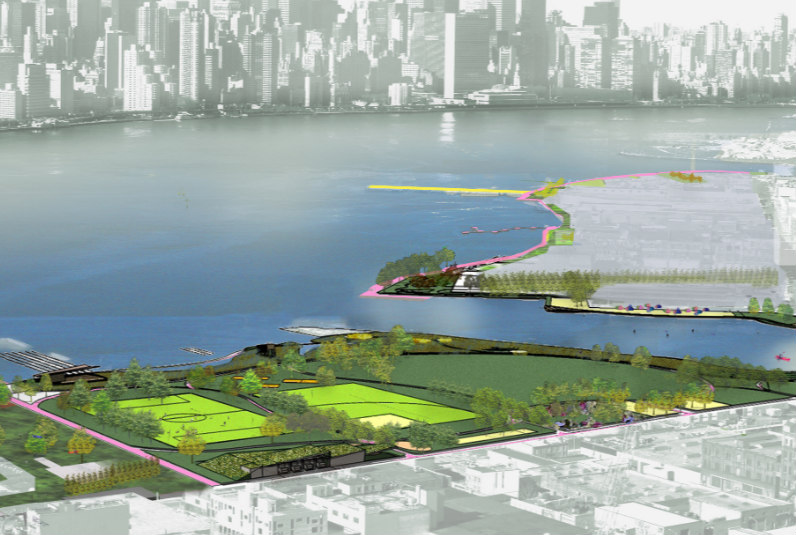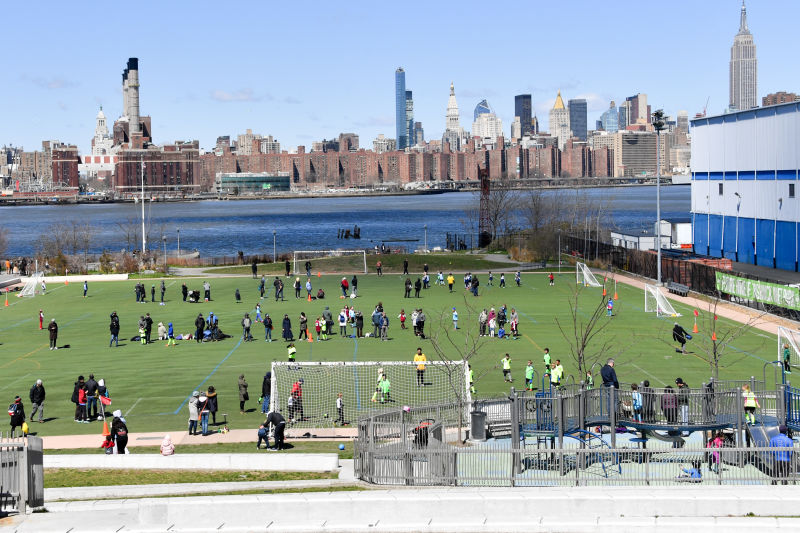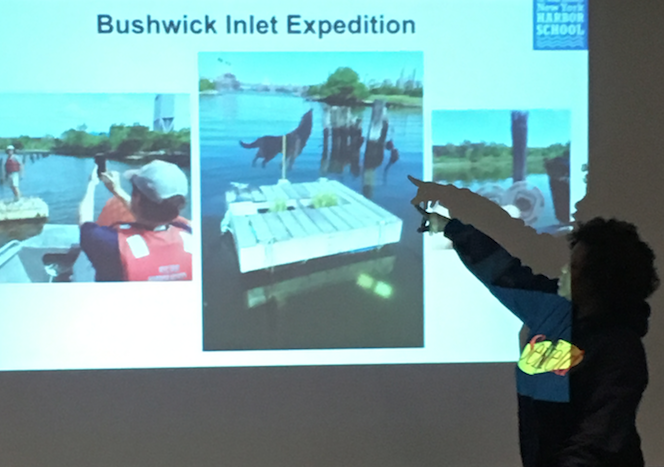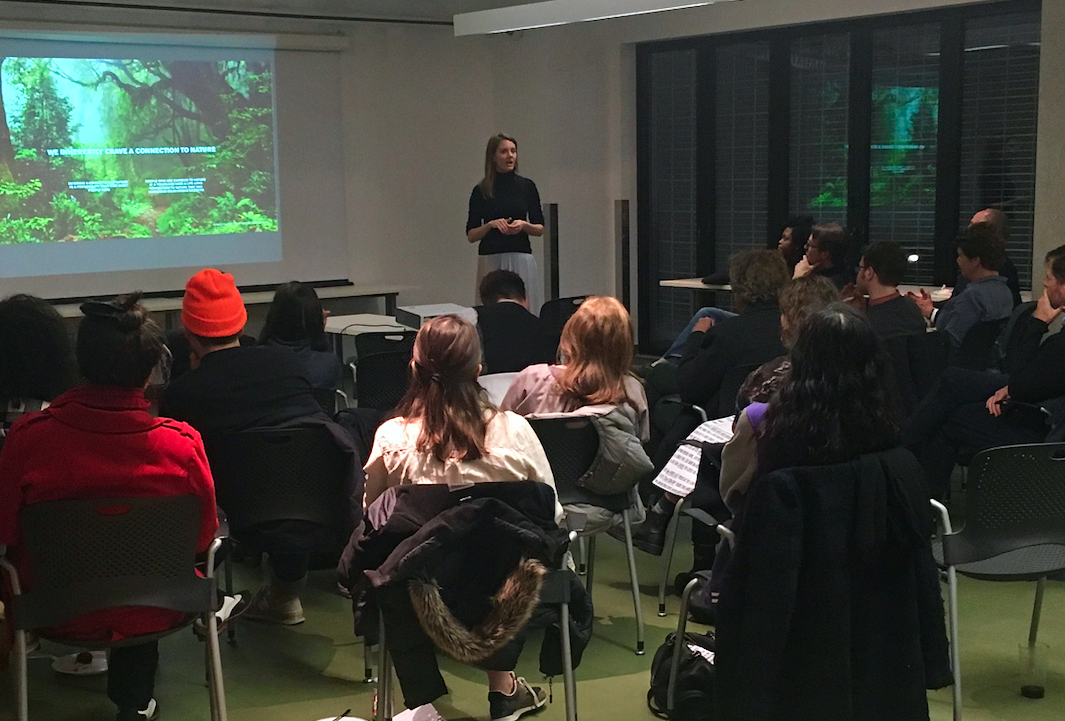by Chris Cobb

Most people would be shocked if they knew the truth of just how polluted the area around Bushwick Inlet Park (BIP) once was- at least until fairly recently. The park, nestled on the waterfront between Williamsburg and Greenpoint on Kent Street, was once home to Charles Pratt’s (founder of the Pratt Institute) Astral Oil Works, which was one of the first oil refineries in the United States. The success of his refinery drew dozens of other refiners along the East River from Williamsburg to Newtown creek, and industrial waste was routinely disposed of in the East River. Over time the pollution from the factories killed off virtually all the marine life in the waterways. After a century of fires, spills and contamination, the land seemed beyond rehabilitation.
But as the oil industry’s presence declined in Brooklyn, things slowly started to change. Between the passage of the Clean Water Act in 1972, and a massive rezoning of the waterfront under Mayor Michael Bloomberg in 2005, the area became attractive to developers. As the water became less polluted, living in Williamsburg and Greenpoint became more appealing.

Today, Bushwick Inlet Park is a green jewel set among the grey former industrial sites which now are occupied by concrete and asphalt residential and commercial developments in Williamsburg and Greenpoint.
This past March, the Friends of Bushwick Inlet Park held its annual meeting which included presentations about how a full 19 acres of green space has been – and will become – an incubator for a number of innovative design and green initiatives.
Katherine Conkling Thompson and Steve Chesler, Co-Chairs of the group, explained the status of the park. The biggest announcement was that two additional parcels had been added because the City had used $17 million (from a 2017 budget) to purchase the land. They noted that testing will be done before any development can be started. The additional parcels will effectively double the area of the green space.
For decades, the ten large oil tanks on the property have sat unused and after various proposals, it was decided by the city to demolish and remove them. Chelser said it was hard to plan for that land because, until the tanks were gone, it was not possible to test the ground beneath them.
Aaniyla Allen, a senior from the New York Harbor School gave an update about the Billion Oyster Project (BOP) which her class is involved with. She reported that in a recent monitoring event, the oysters that her group had counted were healthy and doing well. One measure of success, she said, was that the oysters had grown beyond the structures they had made for them to build colonies on.

Ironically, the fact that they are doing so well – thriving in dense, hard clusters – also makes it hard to determine how many there are, Allan said. Nonetheless, it was all good news and the project appears to be meeting its goal of returning oysters to the East River.
She added that as a side benefit, the project will also rejuvenate the river’s ecosystem, attracting more species of marine life that will live in and among the reefs. As climate change worsens, projects like this will be vital in reducing the vulnerability of the coastal area. Hopefully it can be a model for what is possible elsewhere.
Rob Buchanan, a Field Technician and Boatbuilder with the BOP, was there and mentioned that when last they checked, “there was a good amount of biodiversity & plenty of healthy oysters, but unfortunately nobody had made observations before the project began in order to create a baseline.” As such, the observations being made now will essentially be the baseline by which future progress will be measured.
Emily Bauer of BAU LAND gave a talk about a community garden project that she is helping design at the park with the community. She began by citing a study that found people are 25% happier when exposed to nature on a regular basis. Bauer then did a quick rundown of how gardens help create culture by reflecting the cultures they are produced in. “In the past,” she said, “often gardens had been a display of man’s power.” In contrast to what would be happening at BIP, she mentioned how the park at Manhattan’s Battery Park existed in the context of a historically military space and as such was limited by the site in terms of its potential.

Likewise, Frederick Law Olmsted’s plan for Central Park was chosen out of 33 proposals because, in Bauer’s view, “Olmsted’s park was based on democratic values.” Other proposals for Central Park would have made it into a vast maze-like garden, or a shooting range, which would hardly make a good place to go with your kids on the weekend.
At BIP, however, ecology, preservation and community building are top priorities. Bauer felt such a mandate for a contemporary public garden space was fantastic and unique, adding “We are lucky here to have a soft shoreline, allowing us to to plant diverse vegetation and allowing us to get close to the water. It also allows for seasonal design.” This connection to the water was special because “Nature is immersive because of the opportunity to see, smell, taste, hear and feel it all around you.” An audience member added that Local Law #11 requires native plants to be used when possible in spaces such as this.

Trina McKeever mentioned seeking potential partnerships with local organizations such as National Sawdust or with the Parks Department. McKeever said BIP would love to partner with organizations or businesses that have creative ideas for using the space of the park. Anyone who has suggestions should email info@bushwickinletpark.org.
Both McKeever and Toby Bryce then emphasized how much they can use volunteers in the areas of fundraising – grant writing especially – and marketing and communications. It’s a fantastic opportunity to get involved with one of the key green spaces in Brooklyn and in a small organization, there is a lot of potential to learn and make a real impact. If you want to get involved with Friends of Bushwick Inlet Park, check out their upcoming Watercolor Painting Series on May 20 or their screening of Mamma Mia! Here We Go Again in the park on May 30.
***
Attend Go Green! BK Festival on Saturday, June 1st in McCarren Park from 12-5 PM, to meet park groups and representatives such as North Brooklyn Parks Alliance and Partnerships for Parks, which nurture parks friends’ groups such as Friends of Bushwick Inlet Park. New York Harbor Foundation/Billion Oyster Project and more will join us for the inspiring day. We will have an obstacle course, clothing swap, artists, a bird watch, a soccer game, great local musicians, organizations, nonprofits, educators, and companies all together to celebrate green initiatives.
***
GO GREEN BK’S PREVIOUS STORIES ON BUSHWICK INLET PARK:
- Greenpoint Eco-Hero: Steve Chesler. Romey Louangvilay, November 14, 2018.
- You Bet Your BIP. Jamie Hook, March 1, 2018.
- The Tenacity of the Community: How Friends of Bushwick Inlet Park Succeeded. Romey Louangvilay, December 20, 2016
- Update: Heroes of Bushwick Inlet Park. Charlotte E. Binns, November 22, 2016
- Heroes of Bushwick Inlet Park: Part Two. Charlotte E. Binns, October 4, 2016
- Heroes of Bushwick Inlet Park: Part One. Charlotte E. Binns, September 29, 2016
- Our Favorite Greenpoint Parks. Romey Louangvilay, August 17, 2016.
- Bushwick Inlet Park Advocates Want Their Park. Romey Louangvilay, August 10, 2016
- Rally at City Hall, Save Bushwick Inlet Park. Greenpointers, August 7, 2016.
- Activists Camp Out to Call for Completion of a Brooklyn Park. NY Times, July 11, 2016.
- News About Greenpoint Area Parks. Romey Louangvilay, June 23, 2016.
- Owner of the CitiStorage Site: Take the City’s Generous Offer Now. Romey Louangvilay, June 16, 2016.


